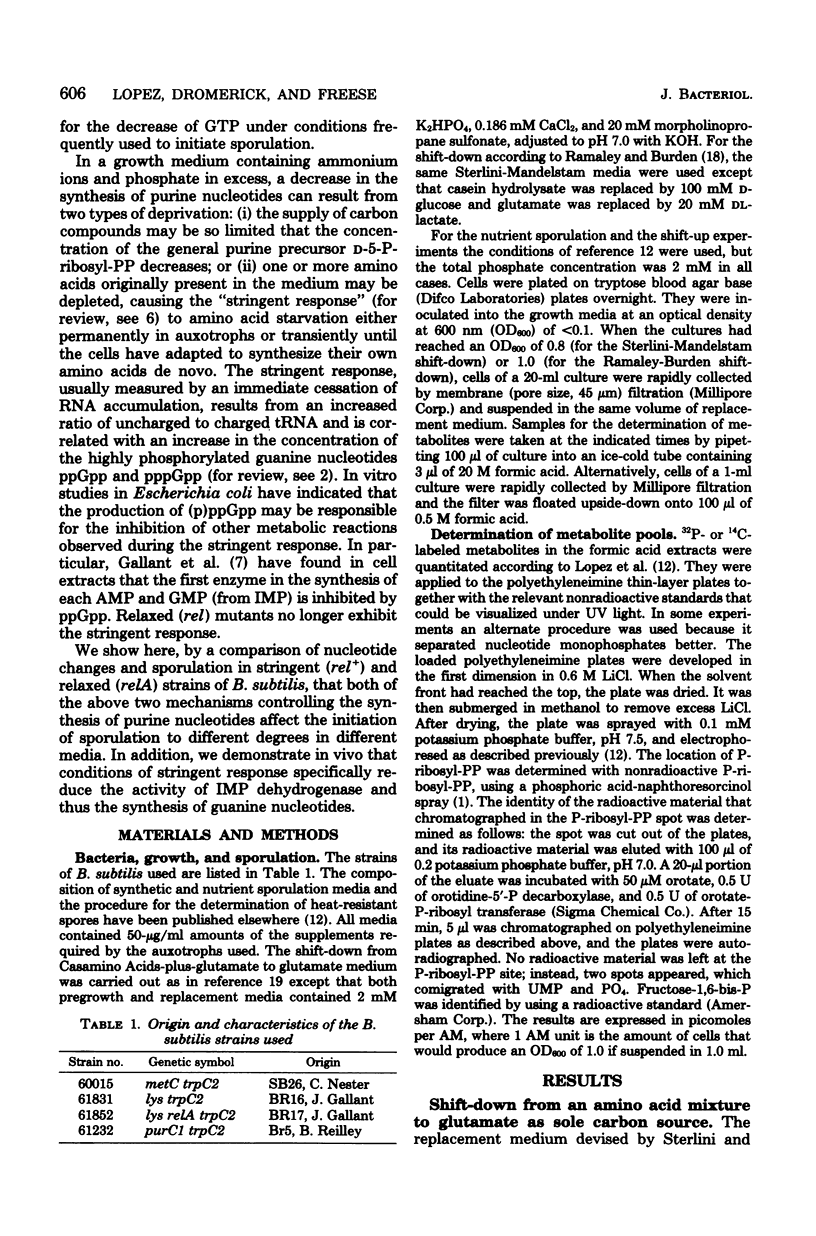Abstract
We have investigated the changes in the guanosine 5′-triphosphate (GTP) and P-ribosyl-PP pools in stringent and relaxed strains of Bacillus subtilis under conditions frequently used to initiate sporulation. After a shift-down from a Casamino Acids-glutamate to a glutamate medium (Sterlini-Mandelstam shift-down), the pools of adenosine 5′-triphosphate and P-ribosyl-PP increased in both strains; in the stringent strain, ppGpp and pppGpp increased and GTP decreased rapidly, whereas in the relaxed strain, ppGpp and pppGpp increased only slightly and GTP decreased only slowly and less extensively. The stringent strain sporulated well, whereas the relaxed strain sporulated late and poorly. Addition of decoyinine, an inhibitor of guanosine 5′-monophosphate synthetase, caused a further decrease of GTP and initiated good sporulation of the relaxed strain. After a shift-down from a glucose-lactate to a lactate medium (Ramaley-Burden shift-down) the pool of P-ribosyl-PP (and GTP) decreased in both strains, indicating a shortage of purine precursors. This shift-down also caused a stringent response which prevented the consumption of nucleotides, as shown by the maintenance of adenosine 5′-triphosphate at a high concentration in the stringent strain but not in the relaxed strain. After a delay, the relaxed strain, in which GTP decreased as fast as in the stringent strain, sporulated also as efficiently. In nutrient sporulation medium the stringent strain and, less effectively, the relaxed strain accumulated ppGpp and pppGpp transiently towards the end of exponential growth. Eventually, the P-ribosyl-PP pool decreased drastically in both strains. In all cases the initiation of sporulation was correlated with a significant decrease of GTP. Granaticin, an antibiotic which prevents the charging of leucyl-transfer ribonucleic acid, was used to show that the stringent response inhibited the formation of xanthosine monophosphate from inosine monophosphate. It prevented the accumulation of xanthosine monophosphate in decoyinine-treated cultures of the stringent strain but not in those of the relaxed strain.
Full text
PDF








Selected References
These references are in PubMed. This may not be the complete list of references from this article.
- Cashel M. Regulation of bacterial ppGpp and pppGpp. Annu Rev Microbiol. 1975;29:301–318. doi: 10.1146/annurev.mi.29.100175.001505. [DOI] [PubMed] [Google Scholar]
- Freese E., Heinze J. E., Galliers E. M. Partial purine deprivation causes sporulation of Bacillus subtilis in the presence of excess ammonia, glucose and phosphate. J Gen Microbiol. 1979 Nov;115(1):193–205. doi: 10.1099/00221287-115-1-193. [DOI] [PubMed] [Google Scholar]
- Gallant J. A. Stringent control in E. coli. Annu Rev Genet. 1979;13:393–415. doi: 10.1146/annurev.ge.13.120179.002141. [DOI] [PubMed] [Google Scholar]
- Gallant J., Irr J., Cashel M. The mechanism of amino acid control of guanylate and adenylate biosynthesis. J Biol Chem. 1971 Sep 25;246(18):5812–5816. [PubMed] [Google Scholar]
- Gallant J., Margason G. Amino acid control of messenger ribonucleic acid synthesis in Bacillus subtilis. J Biol Chem. 1972 Apr 25;247(8):2289–2294. [PubMed] [Google Scholar]
- Heinze J. E., Mitani T., Rich K. E., Freese E. Induction of sporulation by inhibitory purines and related compounds. Biochim Biophys Acta. 1978 Nov 21;521(1):16–26. doi: 10.1016/0005-2787(78)90245-9. [DOI] [PubMed] [Google Scholar]
- Lazzarini R. A., Cashel M., Gallant J. On the regulation of guanosine tetraphosphate levels in stringent and relaxed strains of Escherichia coli. J Biol Chem. 1971 Jul 25;246(14):4381–4385. [PubMed] [Google Scholar]
- Lopez J. M., Marks C. L., Freese E. The decrease of guanine nucleotides initiates sporulation of Bacillus subtilis. Biochim Biophys Acta. 1979 Oct 4;587(2):238–252. doi: 10.1016/0304-4165(79)90357-x. [DOI] [PubMed] [Google Scholar]
- Lopez J. M., Uratani-Wong B., Freese E. Catabolite repression of enzyme synthesis does not prevent sporulation. J Bacteriol. 1980 Mar;141(3):1447–1449. doi: 10.1128/jb.141.3.1447-1449.1980. [DOI] [PMC free article] [PubMed] [Google Scholar]
- Mitani T., Heinze J. E., Freese E. Induction of sporulation in Bacillus subtilis by decoyinine or hadacidin. Biochem Biophys Res Commun. 1977 Aug 8;77(3):1118–1125. doi: 10.1016/s0006-291x(77)80094-6. [DOI] [PubMed] [Google Scholar]
- Nishino T., Gallant J., Shalit P., Palmer L., Wehr T. Regulatory nucleotides involved in the Rel function of Bacillus subtilis. J Bacteriol. 1979 Nov;140(2):671–679. doi: 10.1128/jb.140.2.671-679.1979. [DOI] [PMC free article] [PubMed] [Google Scholar]
- Ogilvie A., Wiebauer K., Kersten W. Inhibition of leucyl-transfer ribonucleic acid synthetasymol. Biochem J. 1975 Dec;152(3):511–515. doi: 10.1042/bj1520511. [DOI] [PMC free article] [PubMed] [Google Scholar]
- Ramaley R. F., Burden L. Replacement sporulation of Bacillus subtilis 168 in a chemically defined medium. J Bacteriol. 1970 Jan;101(1):1–8. doi: 10.1128/jb.101.1.1-8.1970. [DOI] [PMC free article] [PubMed] [Google Scholar]
- Sterlini J. M., Mandelstam J. Commitment to sporulation in Bacillus subtilis and its relationship to development of actinomycin resistance. Biochem J. 1969 Jun;113(1):29–37. doi: 10.1042/bj1130029. [DOI] [PMC free article] [PubMed] [Google Scholar]


